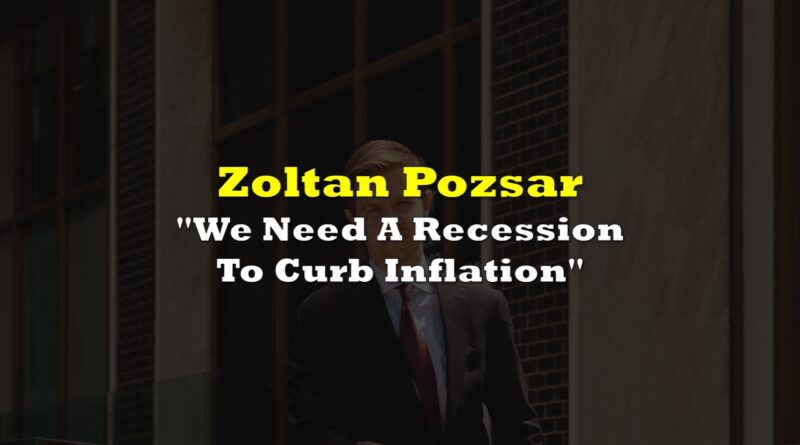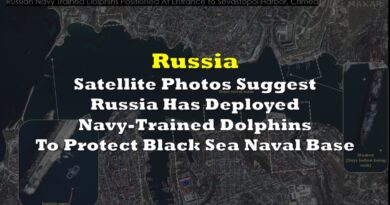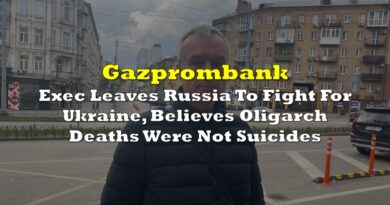Zoltan Pozsar: “We Need A Recession To Curb Inflation”
For Credit Suisse contributor Zoltan Pozsar, the current economic situation isn’t just a mere economic event that would be tapered by fiscal policy. Thus, the ballooning inflation shouldn’t be viewed and treated as such, and even be addressed with out-of-the-box solutions like an induced recession.
“Welcome to the war economy…where heads of state matter more than heads of central banks,” Pozsar opened.
This is (economic) war
Continuing on his Bretton Woods III theory and the shift to a new world order tied to commodities where he believes that statecraft should be included in the hierarchy of money, Pozsar further argues that the geopolitical risk caused by the Russia-Ukraine war complicated the macroeconomic equations as we understand it. Arguments about inflation nearing its peak should be viewed with caution, especially when we “live in an unstable world where geopolitical risk premia are rising and where supply-side issues are more powerful than demand management.”
“Central banks went from waging a war against deflationary impulses coming from the globalization of cheap resources (labor, goods, and commodities), to ‘cleaning up’ the inflationary impulses coming from a complex economic war,” Pozsar added.
As he had submitted before that the world is shifting to a commodities-based economic world order, demand management simply isn’t going to cut it at a time when supply dictates the situation–interest rate policies won’t be enough.
“If we’re right that the economic war is the right context to understand inflation, then Western central banks will not have any good options to slay inflation. They can surely reduce demand by raising rates, but what if supply curves shift inward faster than demand curves?” he argued.
Instead of viewing the economic situation we’re facing as cyclical–hence, inflation is about to peak–Pozsar argues that this can be viewed as structural: “a messy transition to a multipolar world order.” In that case, “inflation has barely started, and could actually be understood as an outright instrument of war.”
“Today, it’s time to think more about the risk of inflation staying higher for longer due to economic warfare, and less about inflation being driven by a messy re-opening process and stimulus,” he added.
“Inflation today is simply everywhere”
The current inflation problem isn’t just sparked by recent events. For Pozsar, this is mostly about the ‘revenge’ of headline inflation–as the economy tries to self-correct years of tightening the labor market due to “protectionist immigration policies in the U.S. or Brexit in the U.K.,” and a cooled down market and early retirement as the world reels in from the pandemic.
While food and energy prices spiked when the Russia-Ukraine war broke–leading to a fiscal and commodities war between Moscow and the West–this has been retroactively impacted by protectionist tariffs imposed on the megasupplier China, as well as the latter’s harsh zero-COVID policy lockdowns that put a chokehold on major international supply chains.
“Inflation today is simply everywhere. It’s plain impossible to talk to anyone who doesn’t complain about rising prices, or to read the financial press without articles about inflation… As James Aitken recently noted, ‘inflation expectations are well anchored when nobody talks about inflation,’ and by that measure, inflation expectations are becoming clearly unanchored,” Pozsar noted.
Citing an observation from a fellow junior analyst that the current situation had most economic forecasts failing, including the Federal Reserves, Pozsar then argued if “an economist straight out of university gets that…inflation is impossible to forecast, why is the market so confident that inflation is about to peak?”
He further added that given the tight labor market, constricted supply, and raging inflation, “central banks won’t be able to get out of QE (no QT), even as inflation is likely to remain high.”
“We need an L-shaped economic activity”
Pozsar added that the Fed’s tightening campaign is structural, driven by the unique situation where “supply of cheap labor, goods, and energy is over and the level of demand is too high and didn’t respond to lower supply fast enough.”
“[We’re] now playing “catch-down” to the post-nativist, post-Covid, and post-Ukraine trend of aggregate supply. The level of economic activity needs to adjust down in an “L”-shaped manner. If it doesn’t, we will have more inflation problems,” Pozsar theorized.
Citing Bill Dudley’s opinion articles in Bloomberg, he challenged the thought on why the Fed expects “inflation to slow to target when it does not forecast either a recession or a material increase in the unemployment rate.”
“[If] the inward shift of supply curves across multiple fronts (labor, goods, and commodities) is the main driver of today’s inflation; if demand needs to be curbed significantly to slow inflation; and if a substantial reduction of aggregate demand means an “L”-shaped path for the economy, why is it so bloody hard to see that we need a recession to curb inflation?” Pozsar asked.
The L-shaped economic activity would have to include a deep plunge followed by a possible stagnation–where interest rates might also have to “be kept high for a while to ensure that rate cuts won’t cause an economic rebound” that could make the necessary “L” an inevitable “V”.
“To date, I haven’t heard anything from the FOMC that would suggest that the Fed wants to avoid a recession, or that the Fed would rush to cut rates if we had a recession with high inflation,” he added.
“The risk of the Fed hiking to 5% or 6% is very real”
“It’s time to think outside the box and to appreciate the pattern: the Fed went from transitory to not transitory; no hikes to hikes; hikes to a string of rate hikes; a string of 25 bps to a string of 50 bps; a string of 50 bps to a string of 75 bps; a string of 75 bps with forward guidance to the same without any comments,” Pozsar argued.
It might not be that apparent, but Pozsar sees the Fed chief Jerome Powell moving to the recession side of the discussion, albeit slowly because he has “to navigate the political aspects of interest rate hikes.”
“But make no mistake about it: the risk of the Fed hiking to 5% or 6% is very real, and ditto the risk of rates cresting there despite economic and asset price pain,” he added.
Pozsar further explained his view that Powell has a tall task of curbing inflation. And with current risks pointing towards the limited choice between a deep recession and damaging Fed’s reputation as an institution, the author believes “Powell will try his very best to curb inflation, even at the cost of a “depression” and not getting reappointed.”
“Whether Jay Powell will succeed in slaying inflation is not the question; in the context of economic war, we can doubt that. Rather, the question is whether he’ll try his best to slay it. There I have no doubts,” he added.
Moving forward, should an L-shaped economy transpire, ramping up from the stagnation back to growth could be tomorrow’s problem. But given the new world order tied to commodities, “the West will have to develop its own supply of things.”
“And much like the current hiking cycle is not a cycle but a tightening campaign, that recovery won’t be a recovery driven by rate cuts but by fiscally funded industrial policy,” Pozsar ended.
Information for this briefing was found via Credit Suisse. The author has no securities or affiliations related to this organization. Not a recommendation to buy or sell. Always do additional research and consult a professional before purchasing a security. The author holds no licenses.




